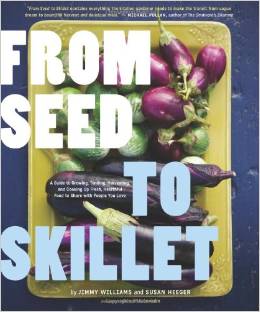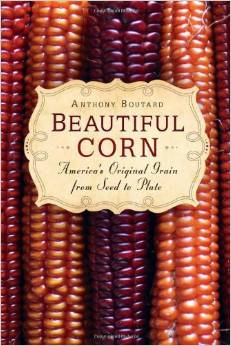Between the Bookends at Becker Library: 14 from '14
/Just as museums have libraries to help them interpret their collections, SSE interprets its collections, too. We work at uncovering contexts for the thousands of varieties existing in our Collection. We need to know both the seeds and their savers, the histories and the cultural contexts, the global picture and the local realities.
So – we have Becker Library. We collect books that help us learn about the truly amazing collection we steward: the people, the communities, the foodways, the gardening practices, the historical contexts, and the potential threats – the whole shebang. Libraries are about the whole shebang. And with that in mind, I'm happy to share 14 diverse titles we acquired during the past year, 2014, and wish you all a very happy 2015! Find a warm stove to cozy up to and read one of these good books this winter!
Forgotten Fruits: A guide to Britain's Traditional Fruit and Vegetables from Orange Jelly Turnips and Dan's Mistake Gooseberries by Christopher Stocks
Windmill, International Edition, 2009
In response to a request from our Preservation staff, we selected this volume as a reference for information on the fascinating and occasionally very strange origins of Britain's forgotten fruit and vegetable varieties. Written in a light combination of encyclopedic and historical narration, Stocks connects varieties to history, telling such stories as how the gooseberry helped Charles Darwin to arrive at his theory of evolution, and how the tomato came to Britain in the 16th century but was considered too poisonous to eat for almost 200 years.
Drawn from Nature: The Botanical Art of Joseph Prestele and His Sons by Charles Van Ravenswaay
Washington, DC: Smithsonian Institution Press, 1984
“Joseph Prestele (1796-1867), a botanical painter and master lithographer, immigrated to the United States from Bavaria in the 1840s. His sons—Joseph Jr., Gottlieb and William Henry—also became botanical artists. In fact, William Henry Prestele (1838-1895) was the first botanical artist hired by the USDA's Division of Pomology, in 1887. The Prestele family produced botanical illustrations for USDA and the Smithsonian Institution, as well as for the nursery and seed trade. Their watercolors and lithographs are highest-quality scientific illustrations, as well as fine art.” (from the Agricultural Research Service of the USDA) Note: The Prestele family lived in the Amana Colonies here in Iowa.
Oriental Vegetables: The Complete Guide for the Gardening Cook by Joy Larkcom
Kodansha USA, 2008
Responding to a request from our Preservation staff for a source for more information on Asian food plants, we purchased this book by British writer Joy Larkcom, who addresses the subject of gardening with oriental vegetables in detail. Alice Waters calls it “indispensable for the gardening cook” using oriental vegetables.
Imitation of Life : a visual catalogue of the 19th century fruit models in the Santos Museum of Economic Botany in the Adelaide Botanic Garden : a collection of papier mâché models made by Heinrich Arnoldi & Co. Gotha, Germany (1856-1899) by Tony Kanellos; Foreword by Stephen Forbes; photographs by Paul Atkins
Published by the Botanic Gardens of Adelaide, this amazing book includes images of 192 apples and 129 pears – presented as an album of portraits – of the fruits recommended for cultivation in South Australia during the late nineteenth century. The surprising element is that the fruits portrayed are actually detailed, true-to-life, papier-mâché models made by a German artist.
Beautiful and Abundant: Building the World We Want by Bryan Welch
Bryan Welch is the publisher of Mother Earth News, Natural Home, and Utne Reader and a keen observer and critic of environmental public policy. This book presents a more positive vision on behalf of the eco-community than is often heard. Welch advocates for a building of consensus and a genuine move forward to create a just, peaceful, and sustainable future. Intended to inspire action and vision rather than debate and gridlock, Welch’s book offers hope as a practical element for moving forward.
Seeds of Resistance, Seeds of Hope: Place and Agency in the Conservation of Biodiversity by Virginia D. Nazarea, Robert E. Rhoades, & Jenna Andrews-Swann, editors
University of Arizona Press; 2nd edition, 2013
Speaking at SSE’s 2014 conference, anthropologist Virginia Nazarea described gardens as “storied, sensual and sovereign;" they have history, they engage our primitive and intimate instincts, and they can create and fix in place personal identity. In an era of urbanization and globalization, a new appreciation of food – from the place it’s grown to the people who grow it – is evident. Home gardening is growing in popularity. Articles representing multiple disciplines help to reminds us all that the conservation of biodiversity and resistance to monocultures is happening at the grassroots of societies around the world.
The Third Plate: Field Notes on the Future of Food by Dan Barber
Penguin Press, 2014
The single copy of this book held by Decorah’s public library was in such demand among SSE staff that a request came from one who was in the queue for checkout, asking SSE to procure this book. Chef Dan Barber has received high praise for this volume that has been compared by reviewers to Michael Pollan’s Omnivore’s Dilemma in its significance. Like the book Beautiful and Abundant, The Third Plate promotes a global view of building more sustainable food systems, based on the simple premise that growing and eating food that is in harmony with the earth will result in the earth’s reciprocation.
The Elements of Organic Gardening by HRH The Prince of Wales and Stephanie Donaldson
Kales Press, 2nd ed., 2007
Prince Charles made public statements over 25 years ago advocating organic gardening and farming principles. In that day – and in his position – his advocacy was seen as eccentric, but he has proved to be a visionary, a leader who get his hands dirty and uses sustainable growing methods in his own gardens at Highgrove, Birkhall and Clarence House. HRH is a believer in that old fashioned word “husbandry” – caring for and cultivating natural resources in general as well as food crops and ornamental plants, understanding the intricate interrelationships of all.
Apples of Uncommon Character: Heirlooms, Modern Classics, and Little-Known Wonders by Rowan Jacobsen
Bloomsbury USA, 2014
Writer of the immensely popular Geography of Oysters, Rowan Jacobsen delves into the wide world of apple varieties. Jacobsen highlights characterful heirloom varieties being rediscovered as well as new breeds being developed. The book includes 150 color photos of varieties from throughout North America, accompanied by stories, recipes, and resources. Luscious to look at!
The Garden at Eichstätt by Klaus Walter Littger and Werner Dressendorfer
Taschen, 2000
Considered one of the most famous botanical records in history, the original volume (1613) documented flowers and fruits grown in the greatest German garden of its day. Basilius Besler, botanist at Eichstätt, recruited ten engravers to help transfer drawings made in situ onto copper plates. Seed Savers Exchange acquired this facsimile reprint volume in part because of a pepper variety in our Preservation collection called 'Besler’s Cherry' pepper, which we believe to be represented in one of the illustrations.
The New American Landscape: Leading Voices on the Future of Sustainable Gardening edited by Thomas Christopher
Timber Press, 2011
The New American Landscape is a balanced, thorough, thoughtful, and practical guide with a number of contributors writing on the subject of gardening sustainably. It is useful for seasoned gardeners as well as beginners, and includes subjects of interest to gardeners everywhere. The writers come to the subject from various perspectives and experiences in horticulture, ranging from academics to nursery workers and landscape horticulturists. The editor, Thomas Christopher, is a seasoned reporter, writer, and blogger on the subjects of gardening and environmental issues.
From Seed to Skillet: A Guide to Growing, Tending, Harvesting, and Cooking Up Fresh, Healthy Food to Share with People You Love by Jimmy Williams and Susan Heeger; Eric Staudenmaier, photographer
Chronicle Books, 2010
A highly rated, basic, step-by-step gardening book, From Seed to Skillet was written by Jimmy Williams, whose grandmother taught him the gardening arts. She was a South Carolina native from a traditional Gullah community, a descendent of Caribbean slaves. A manual for planning, designing, and constructing a chemical-free garden, the book also includes Jimmy's favorite family recipes.
Beautiful Corn: America's Original Grain from Seed to Plate
by Anthony Boutard
New Society Publishers, 2012
Lorna Sass (Whole Grains Every Day, Every Way) called Beautiful Corn a “lyrical love letter to an ancient, fascinating food.” Boutard has written a comprehensive, clear, and instructive book about one of America’s gifts to the world, sharing political, scientific, historical, and practical information about corn culture and “whole food” in all its diversity.
Gardening the Amana Way by Lawrence L. Rettig
University of Iowa Press, 2013
Lawrence Rettig was born in 1941 in Middle Amana, Iowa, to parents who were born and raised in Iowa’s Community of True Inspiration. He maintains a fourth-generation vegetable garden including many of the heirloom varieties raised by the inhabitants of the Colonies. His gardening instruction includes traditional Amana-style planting, harvesting, and storing vegetables and fruits, drawing on age-old techniques born in central Europe.
Seed Savers Exchange is a non-profit organization located in Decorah, Iowa, with a mission to conserve and promote America's culturally diverse but endangered garden and food crop heritage for future generations by collecting, growing, and sharing heirloom seeds and plants.



























